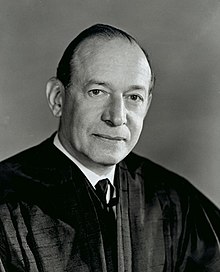
Back آبي فورتاس Arabic ايب فورتاس ARZ Abe Fortas German Abe Fortas French אייב פורטאס HE Աբրամ Ֆորտաս Armenian Abe Fortas ID Abe Fortas Portuguese Фортас, Абрам Russian Abe Fortas SIMPLE
Abe Fortas | |
|---|---|
 | |
| Associate Justice of the Supreme Court of the United States | |
| In office October 4, 1965 – May 14, 1969[1] | |
| Nominated by | Lyndon B. Johnson |
| Preceded by | Arthur Goldberg |
| Succeeded by | Harry Blackmun |
| United States Under Secretary of the Interior | |
| In office January 1, 1944 – January 12, 1946 | |
| President | Franklin D. Roosevelt Harry S. Truman |
| Preceded by | Himself |
| Succeeded by | Oscar L. Chapman |
| In office June 23, 1942 – November 16, 1943 | |
| Preceded by | John J. Dempsey |
| Succeeded by | None (position vacant) |
| Personal details | |
| Born | Abraham Fortas June 19, 1910 Memphis, Tennessee, U.S. |
| Died | April 5, 1982 (aged 71) Washington, D.C., U.S. |
| Political party | Democratic |
| Spouse |
Carolyn Agger (m. 1935) |
| Education | Rhodes College (BA) Yale University (LLB) |
| Military service | |
| Allegiance | United States |
| Branch/service | United States Navy |
| Years of service | 1943 |
| Rank | Seaman Apprentice |
| Unit | Naval Training Station Sampson, New York |
Abraham Fortas (June 19, 1910 – April 5, 1982) was an American lawyer and jurist who served as an associate justice of the Supreme Court of the United States from 1965 to 1969. Born and raised in Memphis, Tennessee, Fortas graduated from Rhodes College and Yale Law School. He later became a law professor at Yale Law School and then an advisor for the U.S. Securities and Exchange Commission. Fortas worked at the Department of the Interior under President Franklin D. Roosevelt, and was appointed by President Harry S. Truman to delegations that helped set up the United Nations in 1945.
In 1948, Fortas represented Lyndon B. Johnson in the dispute over the Democratic U.S. Senate nomination, and he formed close ties with Johnson. Fortas also represented Clarence Earl Gideon before the U.S. Supreme Court, in a landmark case involving the right to counsel. Nominated by Johnson to the Supreme Court in 1965, Fortas was confirmed by the Senate, and maintained a close working relationship with the president. As a justice, Fortas wrote several notable majority opinions including Tinker v. Des Moines Independent Community School District.
In 1968, Johnson tried to elevate Fortas to the position of Chief Justice of the United States, but that nomination faced a filibuster and was withdrawn. Fortas later resigned from the Court after a controversy involving his acceptance of $20,000 from financier Louis Wolfson while Wolfson was being investigated for insider trading. The Justice Department investigated Fortas at the behest of President Richard Nixon, who saw replacing Fortas as a chance to move the Court in a more conservative direction. Attorney General John N. Mitchell pressured Fortas into resigning.[2] Following his resignation, Fortas returned to private practice, occasionally appearing before the justices with whom he had served.
- ^ "Justices 1789 to Present". Washington, D.C.: Supreme Court of the United States. Retrieved February 21, 2022.
- ^ Dean, John (February 2002). The Rehnquist Choice. Free Press. pp. 5–10. ISBN 9780743229791. Retrieved July 2, 2022.
© MMXXIII Rich X Search. We shall prevail. All rights reserved. Rich X Search